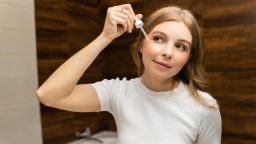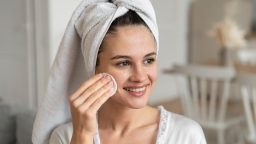The term „clean beauty” has been making waves in the beauty industry, with many brands and consumers embracing it as a more ethical, safe, and sustainable approach to skincare and makeup. But with so much buzz around the term, it can be difficult to define exactly what clean beauty means and what it stands for. Is it just another marketing term, or is it a genuine shift in how we approach beauty products? Let’s dive into the truth behind clean beauty and what you need to know.
What Is Clean Beauty?
At its core, clean beauty refers to products that are formulated without ingredients known to be harmful to human health or the environment. While the exact definition can vary depending on the brand or retailer, the key principles behind clean beauty revolve around the use of safe, non-toxic ingredients, sustainability, and ethical practices in product development. This includes:
- No harmful chemicals: Clean beauty products aim to avoid ingredients that are linked to negative health effects, such as parabens, sulfates, phthalates, synthetic fragrances, and certain preservatives.
- Transparency: Clean beauty brands often prioritize transparency by disclosing their ingredient lists and providing information about the sourcing, production, and testing processes.
- Ethical and sustainable practices: Clean beauty brands often emphasize cruelty-free testing, environmentally friendly packaging, and responsible sourcing of ingredients.
While the clean beauty movement encourages healthier alternatives to conventional beauty products, it’s important to note that there isn’t a universal standard or certification for what constitutes “clean.” However, many clean beauty brands are committed to offering products that are better for both you and the planet.
The Difference Between Clean, Green, Natural, and Organic Beauty
You’ve probably heard the terms „natural,” „organic,” and „green” beauty thrown around alongside clean beauty, but what’s the difference? Let’s break it down:
- Natural Beauty: Refers to products made with ingredients sourced from nature, such as plants, minerals, and botanicals. However, natural doesn’t always mean safe or effective. Just because something is natural doesn’t mean it’s free from harmful substances.
- Organic Beauty: Products that are labeled organic typically use ingredients grown without synthetic pesticides, fertilizers, or genetically modified organisms (GMOs). Organic certification varies by country and can include both food and skincare products.
- Green Beauty: Green beauty is an umbrella term that encompasses eco-friendly and sustainable beauty products. Green beauty products are often clean, but the focus is more on environmentally responsible practices, like recyclable packaging and reducing the carbon footprint.
- Clean Beauty: As discussed, clean beauty focuses on the safety and integrity of ingredients and ensures that harmful substances are excluded. While many clean beauty products are natural, clean beauty also prioritizes the effectiveness of ingredients and often includes synthetic ingredients that meet safety standards.
In short, while these terms overlap, clean beauty emphasizes health and safety for both the user and the environment.
Common Harmful Ingredients to Avoid in Conventional Beauty Products
One of the key principles of clean beauty is the exclusion of certain ingredients that are considered harmful or toxic to human health. Here are some common ingredients often avoided in clean beauty products:
- Parabens: These preservatives are used to prevent bacterial growth but have been linked to hormone disruption and reproductive issues. They are commonly found in lotions, shampoos, and deodorants.
- Sulfates: These detergents are used in many cleansers and shampoos to create foam. They can be drying and irritating, especially for sensitive skin or hair.
- Phthalates: Often used to make products more flexible or to extend fragrance wear, phthalates are known endocrine disruptors and have been linked to various health concerns.
- Synthetic Fragrances: Many beauty products contain artificial fragrances, which can cause allergic reactions or skin irritation, especially for those with sensitive skin.
- Formaldehyde and Formaldehyde-Releasing Agents: These preservatives are found in some hair and nail products and are known carcinogens.
- Silicones: While they can provide a smooth texture, silicones can build up on the skin or hair, clog pores, and hinder the skin’s natural ability to breathe.
Clean beauty brands avoid these ingredients, opting for safer alternatives that nourish and protect the skin without the risks.
The Benefits of Clean Beauty Products
Clean beauty products offer several potential benefits, particularly for those who are looking for healthier, more environmentally responsible options. Here are some of the main benefits:
- Safer for Your Health: Clean beauty products are free from harmful chemicals and toxins, which may reduce your risk of irritation, allergic reactions, or long-term health concerns. This is especially important for those with sensitive skin or conditions like eczema or rosacea.
- Better for the Environment: Many clean beauty brands focus on sustainability, using eco-friendly packaging (such as glass or recyclable materials) and sourcing ingredients responsibly. Some brands also prioritize cruelty-free testing and minimize their environmental impact through carbon offsetting or renewable energy sources.
- Transparency and Ethical Practices: Clean beauty brands often disclose ingredient sourcing, production processes, and business practices. This transparency allows consumers to make more informed choices about the products they use and supports ethical and sustainable business practices.
- Nurturing Skin and Hair: Clean beauty products often use natural or minimally processed ingredients that are nourishing and effective. These products aim to enhance your natural beauty, focusing on maintaining healthy, glowing skin and strong, shiny hair.
Are Clean Beauty Products Effective?
Many people wonder if clean beauty products can be as effective as their conventional counterparts, given that they often avoid certain synthetic ingredients. The answer depends on the product and the brand.
While some clean beauty products can be just as effective as conventional products, others may not have the same immediate results. This is because clean beauty often prioritizes natural ingredients, which can take longer to show results compared to synthetic alternatives. However, over time, clean beauty products tend to support long-term skin health, promoting natural radiance and hydration.
It’s also worth noting that just because a product is clean doesn’t mean it’s automatically more effective. The effectiveness of any product depends on its formulation, the active ingredients used, and how they work with your skin type and needs.
Common Misconceptions About Clean Beauty
There are a few myths surrounding clean beauty that might cause confusion or hesitation when trying these products:
- Clean Beauty Is Always Natural or Organic: While clean beauty emphasizes safe, non-toxic ingredients, it doesn’t necessarily mean the products are 100% natural or organic. Some clean beauty brands use synthetic ingredients that are considered safe and effective.
- Clean Beauty Doesn’t Work: Clean beauty products can be just as effective, if not more so, than conventional beauty products. Many clean beauty brands invest in research and development to create formulas that are both safe and highly effective.
- Clean Beauty Is Only for Sensitive Skin: While clean beauty is often recommended for those with sensitive skin, it’s suitable for everyone. Even if you have normal or oily skin, clean beauty products can provide a safe, nourishing option for your skincare routine.
- All Natural Ingredients Are Safe: Not all natural ingredients are safe for everyone. For example, essential oils and certain plant extracts can cause irritation or allergic reactions in some people. Clean beauty prioritizes ingredient safety, whether it’s natural or synthetic.
How to Transition to Clean Beauty
If you’re interested in trying clean beauty, it’s best to make the transition gradually. Here’s how you can start:
- Check your ingredients: Begin by reading the ingredient lists of your current beauty products. Look for common chemicals and preservatives like parabens, sulfates, and phthalates, and make note of which products contain them.
- Research clean beauty brands: Start by researching trusted clean beauty brands that align with your values. Look for those with transparent ingredient lists and eco-friendly practices.
- Swap out one product at a time: It’s not necessary to replace everything all at once. Start by swapping out products that you use frequently, such as cleansers or moisturizers, for clean alternatives.
- Patch test new products: Even though clean beauty products are typically gentler, it’s always a good idea to patch-test new products to ensure they don’t cause irritation.
Conclusion
Clean beauty isn’t just a trend; it’s a movement that encourages transparency, safety, and sustainability in the beauty industry. By choosing clean beauty products, you can help protect your skin from harmful chemicals, support environmentally friendly practices, and choose products that are better for your overall health. While the term „clean” can vary slightly depending on the brand, it generally refers to products that are free from harmful chemicals, cruelty-free, and created with ethical practices. Whether you’re new to clean beauty or a long-time supporter, making mindful choices in the products you use can help you achieve healthier, radiant skin while supporting a more sustainable future.





